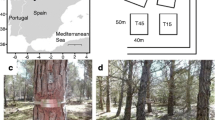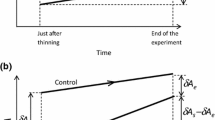Abstract
• Context
This research was conducted in a 62-year-old stone pine (Pinus pinea L.) forest within the National Natural Reserve of the Roman Coast, Italy. Net under-canopy precipitation was measured between September 2004 and December 2008 in a unthinned and a thinned area of about 1 ha each.
• Aims
The goals were to document and compare net under-canopy rainfall (throughfall and stemflow) in thinned and unthinned stands, and evaluate how the re-growth of tree crowns following thinning influences canopy interception.
• Methods
Thinning was carried out during the winter of 2002 and reduced the number of trees by 56% and leaf area index (LAI) by 63%. Rainfall, throughfall, and stemflow were measured and analysed.
• Results
Interception loss averaged 23% and 40% in the thinned and unthinned areas respectively, but difference decreased during larger rainfall events. Net under-canopy precipitation was always higher (P < 0.001) in the thinned area, and showed a significant (P = 0.041) relationship with LAI. Stemflow was very low.
• Conclusion
These results highlight the positive effect of thinning, which reduces water loss from precipitation caused by interception of rainfall in Mediterranean forests that have never been thinned. Thinning guarantees a greater flow of water under the canopy, particularly in the driest months and for lower amounts of rainfall, and improves stand growth rates.









Similar content being viewed by others
References
Aussenac G (1968) Interception des précipitations par le couvert forestier. Ann Sci For 25:135–156
Aussenac G, Granier A (1988) Effect of thinning on water stress and growth in Douglas fir. Can J For Res 18:100–105
Brunetti M, Maugeri M, Monti F, Nanni T (2006) Temperature and precipitation in Italy in the last two centuries from homogenised instrumental time series. Int J Climatol 26:345–381
Calder IR (1986) A stochastic model of rainfall interception. J Hydrol 89:65–71
Callegari G, Iovino F, Veltri A (2001) Influenza dei diradamenti sul processo di intercettazione in rimboschimenti di pino laricio. Atti del III Congresso Nazionale della Società Italiana di Selvicoltura ed Ecologia Forestale, pp 143–146
Camuffo D, Pagan E (2003) Analisi di serie storiche di temperatura e precipitazione in località prossime agli speleotemi. Studi Trent Sci Nat Acta Geol 80:37–47
Cape JN, Brown AHF, Robertson SMC, Howson G, Paterson IS (1991) Interspecies comparisons of throughfall and stemflow at three sites in northern Britain. For Ecol Manage 46:165–177
Crockford RH, Richardson DP (2000) Partitioning of rainfall into throughfall, stemflow and interception: effect of forest type, ground cover and climate. Hydrol Process 14:2903–2920
Cubasch U, von Storch H, Waszkewitz J, Zorita E (1996) Estimates of climate change in Southern Europe derived from dynamical climate model output. Clim Res 7:129–149
Cutini A, Matteucci G, Scarascia MG (1998) Estimation of leaf area index with the Li-Cor LAI 2000 in deciduous forests. For Ecol Manage 105:55–65
Cutini A, Amorini E, Manetti MC (2002) Sul ruolo della gestione e del trattamento selvicolturale nella vicenda della Pineta di Castel Fusano. Monti Boschi 3:4–9
Cutini A, Hajny M, Gugliotta OI, Manetti MC, Amorini E (2009) Effetti della struttura del popolamento sui modelli di stime del volume e della biomassa epigea (Pineta di Castelfusano – Roma). Forest@ 6:75–84. doi:10.3832/efor0569-006
Dünkeloh A, Jacobeit J (2003) Circulation dynamics of mediterranean precipitation variability 1948–98. Int J Climatol 23:1843–1866
Dunkerley D (2000) Measuring interception loss and canopy storage in dryland vegetation: a brief review and evaluation of available research strategies. Hydrol Process 14:669–678
Gash JHC, Morton AJ (1978) An application of the Rutter model to the estimation of the interception loss from Thetford forest. J Hydrol 38:49–59
Gibelin AL, Déqué M (2002) Anthropogenic climate change over the Mediterranean region simulated by a global variable resolution model. Clim Dyn 20:327–339
Hall LR (2003) Interception loss as a function of rainfall and forest types: stochastic modelling for tropical canopies revisited. J Hydrol 280:1–12
Hamed KH (2008) Trend detection in hydrologic data: the Mann–Kendall trend test under the scaling hypothesis. J Hydrol 349:350–363
Iovino F, Callegari G, Veltri A (2001) Bilancio idrologico in rimboschimenti di pino laricio. S.I.S.E.F. Atti II, Edizioni Avuenue Media, Bologna, pp 51–53
Iovino F, Borghetti M, Veltri A (2009) Foreste e ciclo dell’acqua. Forest@ 6:256–273. doi:10.3832/efor0583-006
IPCC (2001) Climate Change 2001: the scientific basis. Contribution of Working Group I. In: Houghton JTY et al (eds) Third Assessment Report of the Intergovernmental Panel on Climate Change. Cambridge University Press, Cambridge, UK
IPCC, WG I (2007) Climate Change 2007: The Physical Science Basis. Contribution of Working Group I. In: Solomon S et al (eds) Fourth Assessment Report of the Intergovernmental Panel on Climate Change. Cambridge University Press, Cambridge, UK
Llorens P, Poch R, Latron J, Gallart F (1997) Rainfall interception by a Pinus Sylvestris forest patch overgrown in a Mediterranean mountainous abandoned area I. Monitoring design and results down to the event scale. J Hydrol 199:331–345
Llorens P, Domingo F (2007) Rainfall partitioning by vegetation under Mediterranean conditions. A review of studies in Europe. J Hydrol 335:37–54
Loustau D, Berbigier P, Granier A, El Hadj Moussa F (1992) Interception loss, throughfall and stemflow in a maritime pine stand. I. Variability of throughfall and stemflow beneath the pine canopy. J Hydrol 138:449–467
Lankreijer HJM, Hendriks MJ, Klaassen W (1993) A comparison of models simulating rainfall interception of forests. Agric For Meteorol 64:187–199
Mariani L (2006) Alcuni metodi per l’analisi delle serie storiche in agrometeorologia. Ital J Agrometeorol 2:48–56
Martín-Benito D, Del Río M, Heinrich I, Helle G, Cañellas I (2010) Response of climate-growth relationships and water use efficiency to thinning in a Pinus nigra afforestation. For Ecol Manage 259:967–975
Masarotto G (2005) Analisi delle Serie Temporali con R. http://sirio.stat.unipd.it/files/ts02-03/ts2.pdf
Osborne CP, Mitchell PL, Sheehy JE, Woodward FI (2000) Modelling the recent impacts of atmospheric CO2 and climate change on Mediterranean vegetation. Global Change Biol 6:445–458
R Development Core Team (2008) R: A Language and Environment for Statistical Computing. R Foundation for Statistical Computing, Vienna, Austria. http://cran.r-project.org/
Ricci V (2005) Analisi delle serie storiche con R. http://cran.r-project.org/doc/contrib/Ricci-ts-it.pdf
Rutter AJ (1975) The hydrological cycle in vegetation. In: Monteith JL (ed) Vegetation and the atmosphere, vol 1, Chap 4. Academic, London, pp 111–154
Scarascia Mugnozza G, Valentini R, Spinelli R, Giordano E (1988) Osservazioni sul ciclo dell’acqua in bosco in un bosco ceduo di Quercus cerris L. Annali dell’Accademia Italiana di Scienze Forestali XXXVII:3–21
Simonin K, Kolb TE, Montes-Helu M, Koch GW (2007) The influence of thinning on components of stand water balance in a ponderosa pine stand during and after extreme drought. Agric For Meteorol 143:266–276
Stogsdill WR, Wittwer RF, Hennessey TC, Dougherty PM (1989) Relationship between throughfall and stand density in a Pinus taeda plantation. For Ecol Manage 29:105–113
Waring RH (1983) Estimating forest growth and efficiency in relation to canopy leaf area. Adv Ecol Res 13:327–354
Whitehead D, Kelliher FM (1991) A canopy water balance model for a Pinus radiata stand before and after thinning. Agric For Meteorol 55:109–126
Acknowledgements
This research was funded by the Municipality of Rome project “Management of stone pine (Pinus pinea L.) pinewood within the National Natural Reserve of the Roman Coast” and partially financed by the Italian Ministry of Agricultural and Forestry Policies project Ri.SELV.ITALIA – 3.1.1 “Management and conservation of stone pine coastal stands”. We are grateful to the Centro di Educazione Ambientale (CEA) of the National Natural Reserve of the Roman coast for collecting throughfall and stemflow data. We wish to thank the technical staff of the Research Centre for Silviculture (CRA-SEL) for their field assistance and collecting data.
Author information
Authors and Affiliations
Corresponding author
Additional information
Handling Editor:
Gilbert Aussenac
Contribution of the co-authors
All authors contributed equally to this research
Rights and permissions
About this article
Cite this article
Mazza, G., Amorini, E., Cutini, A. et al. The influence of thinning on rainfall interception by Pinus pinea L. in Mediterranean coastal stands (Castel Fusano—Rome). Annals of Forest Science 68, 1323–1332 (2011). https://doi.org/10.1007/s13595-011-0142-7
Received:
Accepted:
Published:
Issue Date:
DOI: https://doi.org/10.1007/s13595-011-0142-7




